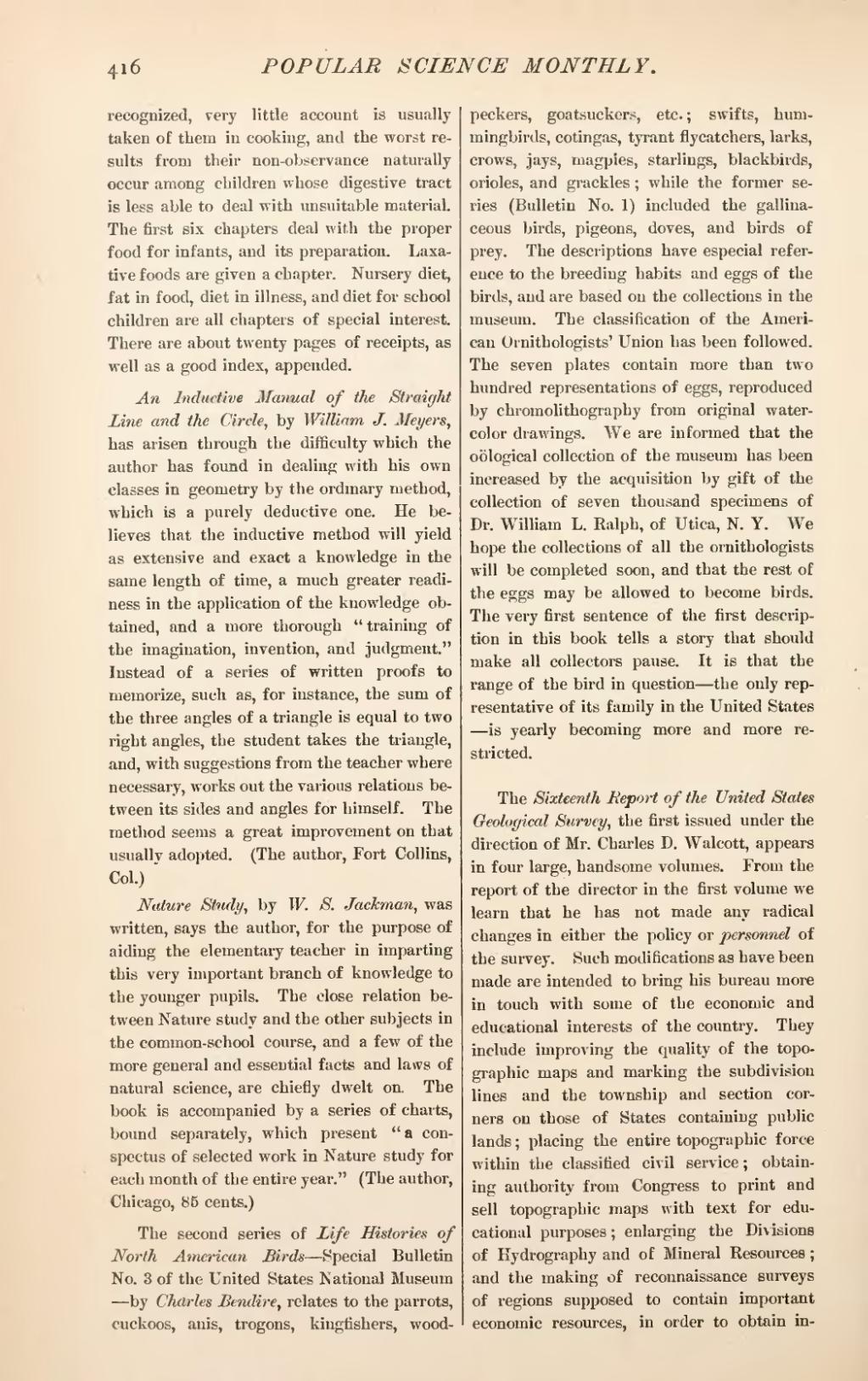recognized, very little account is usually taken of them in cooking, and the worst results from their non-observance naturally occur among children whose digestive tract is less able to deal with unsuitable material. The first six chapters deal with the proper food for infants, and its preparation. Laxative foods are given a chapter. Nursery diet, fat in food, diet in illness, and diet for school children are all chapters of special interest. There are about twenty pages of receipts, as well as a good index, appended.
An Inductive Manual of the Straight Line and the Circle, by William J. Meyers, has arisen through the difficulty which the author has found in dealing with his own classes in geometry by the ordinary method, which is a purely deductive one. He believes that the inductive method will yield as extensive and exact a knowledge in the same length of time, a much greater readiness in the application of the knowledge obtained, and a more thorough "training of the imagination, invention, and judgment." Instead of a series of written proofs to memorize, such as, for instance, the sum of the three angles of a triangle is equal to two right angles, the student takes the triangle, and, with suggestions from the teacher where necessary, works out the various relations between its sides and angles for himself. The method seems a great improvement on that usually adopted. (The author, Fort Collins, Col.)
Nature Study, by W. S. Jackman, was written, says the author, for the purpose of aiding the elementary teacher in imparting this very important branch of knowledge to the younger pupils. The close relation between Nature study and the other subjects in the common-school course, and a few of the more general and essential facts and laws of natural science, are chiefly dwelt on. The book is accompanied by a series of charts, bound separately, which present "a conspectus of selected work in Nature study for each month of the entire year." (The author, Chicago, 85 cents.)
The second series of Life Histories of North American Birds—Special Bulletin No. 3 of the United States National Museum—by Charles Bendire, relates to the parrots, cuckoos, anis, trogons, kingfishers, woodpeckers, goatsuckers, etc.; swifts, hummingbirds, cotingas, tyrant flycatchers, larks, crows, jays, magpies, starlings, blackbirds, orioles, and grackles; while the former series (Bulletin No. 1) included the gallinaceous birds, pigeons, doves, and birds of prey. The descriptions have especial reference to the breeding habits and eggs of the birds, and are based on the collections in the museum. The classification of the American Ornithologists' Union has been followed. The seven plates contain more than two hundred representations of eggs, reproduced by chromolithography from original watercolor drawings. We are informed that the oölogical collection of the museum has been increased by the acquisition by gift of the collection of seven thousand specimens of Dr. William L. Ralph, of Utica, N. Y. We hope the collections of all the ornithologists will be completed soon, and that the rest of the eggs may be allowed to become birds. The very first sentence of the first description in this book tells a story that should make all collectors pause. It is that the range of the bird in question—the only representative of its family in the United States—is yearly becoming more and more restricted.
The Sixteenth Report of the United States Geological Survey, the first issued under the direction of Mr. Charles D. Walcott, appears in four large, handsome volumes. From the report of the director in the first volume we learn that he has not made any radical changes in either the policy or personnel of the survey. Such modifications as have been made are intended to bring his bureau more in touch with some of the economic and educational interests of the country. They include improving the quality of the topographic maps and marking the subdivision lines and the township and section corners on those of States containing public lands; placing the entire topographic force within the classified civil service; obtaining authority from Congress to print and sell topographic maps with text for educational purposes; enlarging the Divisions of Hydrography and of Mineral Resources; and the making of reconnaissance surveys of regions supposed to contain important economic resources, in order to obtain in-
